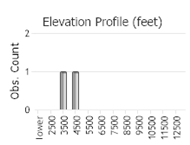View in other NatureServe Network Field Guides
NatureServe
Montana
Utah
Wyoming
Idaho
Wisconsin
British Columbia
South Carolina
Yukon
California
New York
Gladiator Meadow Katydid - Orchelimum gladiator
General Description
The following is taken from Blatchley (1920), Alexander et al. (1972), Vickery and Kevan (1985), Bland (2003), Elliott and Hershberger (2007), Himmelman (2009), and Scott (2010). This is a medium and robust katydid which is aptly named “gladiator.” The body color is bright green and accented with reddish eyes which are darkened toward the front. A brown stripe, with 2 narrow diverging black lines occurs across the dorsal surface of the head and pronotum, which is relatively long with deep lateral sides. The tegmina (forewings) of the female slightly surpasses the hind femur tip but is distinctly longer in males. The male abdominal tip and cerci are bright yellow. The antennae, tarsi, and tip of the female ovipositor dark brown to reddish. The legs are often speckled with dark dots.
Calling song description
Verbal descriptions are: (1) “The song, a series of buzzes lasting up to 5 seconds and usually interspersed with ticks…the buzz does not become louder toward the end…” (Bland 2003). (2) “…buzzes not noticeably louder toward their ends, males may omit the ticks from their songs at night” (Alexander et al. 1972). (3) “A series of ticks followed by a long shuffling trill that starts soft and quickly gains in volume…In areas with dense populations, choruses have a unique wavering quality” (Elliott and Hershberger 2007). (4) “Several ‘tsicks,’ followed by a sustained, soft whir that grows louder toward the end. As with most of the Orchelimum, they will sometimes just ‘tick.’ Calls day and night” (Himmelman 2009).
Phenology
This species overwinters in the egg stage. Adults occur from the end of June to the end of September (Bland 2003).
Diagnostic Characteristics
The following comes from Blatchley (1920), Alexander et al. (1972), Vickery and Kevan (1985), Bland (2003), and Scott (2010). The male body length is 17 mm, and female’s 18-20 mm. The male pronotum is 4.3-5 mm, and female’s 4.7 mm. The male tegmina (forewings) are 19-23 mm, and female’s 19-21 mm. The male hind femur is 12-14 mm, and female’s 15.5-17 mm, the ovipositor is 10 mm. The male cerci has the tip portion beyond the tooth equal to or shorter than the basal portion before the tooth (see illustration box to compare male cerci and female ovipositor morphology and size).
All the Meadow Katydids can be confused with each other. The best method for identification is to compare the measurements and forms of the female ovipositors and male cerci. Refer to the illustration above and the “diagnostic characteristics” section above.
Species Range
Montana Range
Range Descriptions

 Native
Native
Range Comments
The Gladiator Meadow Katydid occurs in a geographical band from the mid-Atlantic and New England states, westward across the southern latitudes of the Canadian Provinces to Saskatchewan where the range bends southward across mid- Washington, all of Oregon and northern border of California. From the north, it extends southward as far as northeast Iowa, across to New Jersey. It is common and widespread over most of its range. In Montana, this species has been reported for 7 counties, but may be more widespread (Vickery and Kevan 1985, Scott 2010, and Walker SINA website 2020).
Observations in Montana Natural Heritage Program Database
Number of Observations: 6
(Click on the following maps and charts to see full sized version)
Map Help and Descriptions
Relative Density

Recency



 (Observations spanning multiple months or years are excluded from time charts)
(Observations spanning multiple months or years are excluded from time charts)
Habitat
This species inhabits the wet, moist edges of marshes, prairies and damp meadows with tall grasses and sedges (Vickery and Kevan 1985, Bland 2003, Elliott and Hershberger 2007).
Food Habits
To date, no detailed studies nor observations specific to this species’ food habits have been found within the published literature. Its diet is probably similar to that other species in the subfamily Conocepahlinae.
Reproductive Characteristics
To date, no detailed studies nor observations specific to this species have been found within the published literature.
References
- Literature Cited AboveLegend:
 View Online Publication
View Online Publication Alexander, R.D., A.E. Pace, and D. Otte. 1972. The singing insects of Michigan. The Great Lakes Entomologist 5(2):33-69.
Alexander, R.D., A.E. Pace, and D. Otte. 1972. The singing insects of Michigan. The Great Lakes Entomologist 5(2):33-69. Bland, R.G. 2003. The Orthoptera of Michigan—Biology, Keys, and Descriptions of Grasshoppers, Katydids, and Crickets. East Lansing, MI: Michigan State University Extension, Bulletin E-2815. 221 p.
Bland, R.G. 2003. The Orthoptera of Michigan—Biology, Keys, and Descriptions of Grasshoppers, Katydids, and Crickets. East Lansing, MI: Michigan State University Extension, Bulletin E-2815. 221 p. Blatchley, W. 1920. Orthoptera of Northeastern America, section Phaneropterinae pp. 459-494. In: Nature Publishing, Indianapolis, IN.
Blatchley, W. 1920. Orthoptera of Northeastern America, section Phaneropterinae pp. 459-494. In: Nature Publishing, Indianapolis, IN. Elliott, L. and W. Hershberger. 2007. The songs of insects. New York, NY: Houghton Mifflin Harcourt. 227 p.
Elliott, L. and W. Hershberger. 2007. The songs of insects. New York, NY: Houghton Mifflin Harcourt. 227 p. Himmelman, J. 2009. Guide to Night-Singing Insects of the Northeast. Mechanicsburg, PA: Stackpole Books. 160 p.
Himmelman, J. 2009. Guide to Night-Singing Insects of the Northeast. Mechanicsburg, PA: Stackpole Books. 160 p. Scott, R.D. 2010. Montana Grasshoppers, Katydids, and Crickets A Pictorial Field Guide to the Orthoptera. MagpieMTGraphics, Billings, MT.
Scott, R.D. 2010. Montana Grasshoppers, Katydids, and Crickets A Pictorial Field Guide to the Orthoptera. MagpieMTGraphics, Billings, MT. Vickery, V. R. and D. K. M. Kevan. 1985. The grasshopper, crickets, and related insects of Canada and adjacent regions. Biosystematics Research Institute, Ottawa, Ontario. Publication Number 1777. 918 pp.
Vickery, V. R. and D. K. M. Kevan. 1985. The grasshopper, crickets, and related insects of Canada and adjacent regions. Biosystematics Research Institute, Ottawa, Ontario. Publication Number 1777. 918 pp. Walker T.J.(ed.). 2020. Singing insects of North America. Accessed 10 February 2021. https://orthsoc.org/sina/
Walker T.J.(ed.). 2020. Singing insects of North America. Accessed 10 February 2021. https://orthsoc.org/sina/
- Additional ReferencesLegend:
 View Online Publication
View Online Publication
Do you know of a citation we're missing? Capinera, J.L., R.D. Scott, and T.J. Walker. 2004. Field Guide to Grasshoppers, Katydids, and Crickets of the United States. Ithaca, NY. Cornell University Press.
Capinera, J.L., R.D. Scott, and T.J. Walker. 2004. Field Guide to Grasshoppers, Katydids, and Crickets of the United States. Ithaca, NY. Cornell University Press. Fulton, B.B. 1933. Stridulating organs of female Tettigoniidae (Orthoptera). Entomological News XLIV:270-275.
Fulton, B.B. 1933. Stridulating organs of female Tettigoniidae (Orthoptera). Entomological News XLIV:270-275. Gwynne, D.T. 2001. Katydids and Bush-Crickets, Reproductive Behavior and Evolution of the Tettigoniidae. Ithaca, NY: Cornell University Press.
Gwynne, D.T. 2001. Katydids and Bush-Crickets, Reproductive Behavior and Evolution of the Tettigoniidae. Ithaca, NY: Cornell University Press. Hebard, M. 1928. The Orthoptera of Montana. Proceedings of the Academy of Natural Sciences of Philadelphia, Vol. 80:211-306.
Hebard, M. 1928. The Orthoptera of Montana. Proceedings of the Academy of Natural Sciences of Philadelphia, Vol. 80:211-306. Helfer, J.R. 1971. How to Know the Grasshoppers, Crickets, Cockroaches, and Their Allies. Revised edition (out of print), Mineola, NY: Dover Publications.
Helfer, J.R. 1971. How to Know the Grasshoppers, Crickets, Cockroaches, and Their Allies. Revised edition (out of print), Mineola, NY: Dover Publications. Morris, G.K. and T.J. Walker. 1976. Calling songs of Orchelimum meadow katydids (Tettigoniidae): I. Mechanism, terminology, and geographic distribution. The Canadian Entomologist 108(8):785-800.
Morris, G.K. and T.J. Walker. 1976. Calling songs of Orchelimum meadow katydids (Tettigoniidae): I. Mechanism, terminology, and geographic distribution. The Canadian Entomologist 108(8):785-800. Rehn, J.A. and M. Hebard. 1914. Studies in American Tettigoniidae. Transactions of the American Entomological Society x1:271-344.
Rehn, J.A. and M. Hebard. 1914. Studies in American Tettigoniidae. Transactions of the American Entomological Society x1:271-344. Sater, S. 2022. The insects of Sevenmile Creek, a pictorial guide to their diversity and ecology. Undergraduate Thesis. Helena, MT: Carroll College. 242 p.
Sater, S. 2022. The insects of Sevenmile Creek, a pictorial guide to their diversity and ecology. Undergraduate Thesis. Helena, MT: Carroll College. 242 p.
- Web Search Engines for Articles on "Gladiator Meadow Katydid"
- Additional Sources of Information Related to "Insects"





